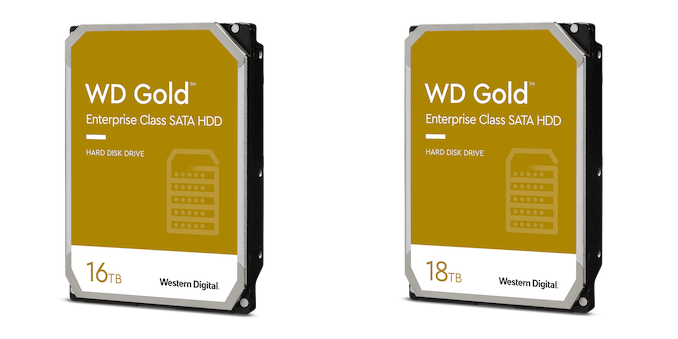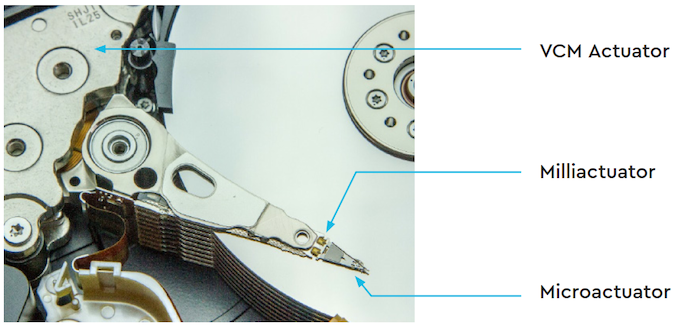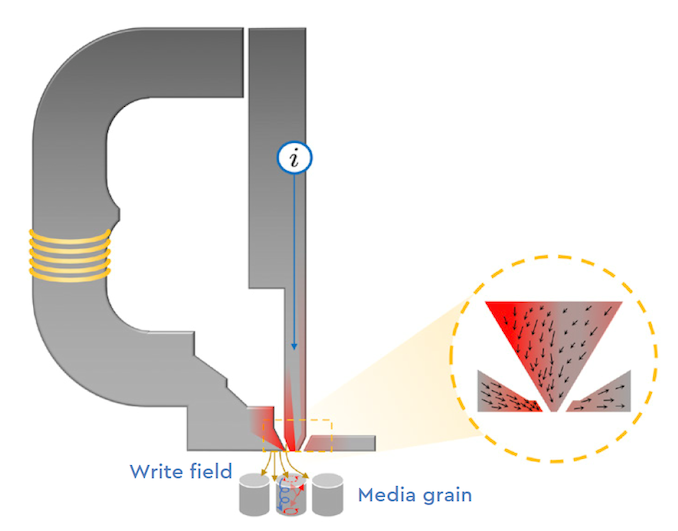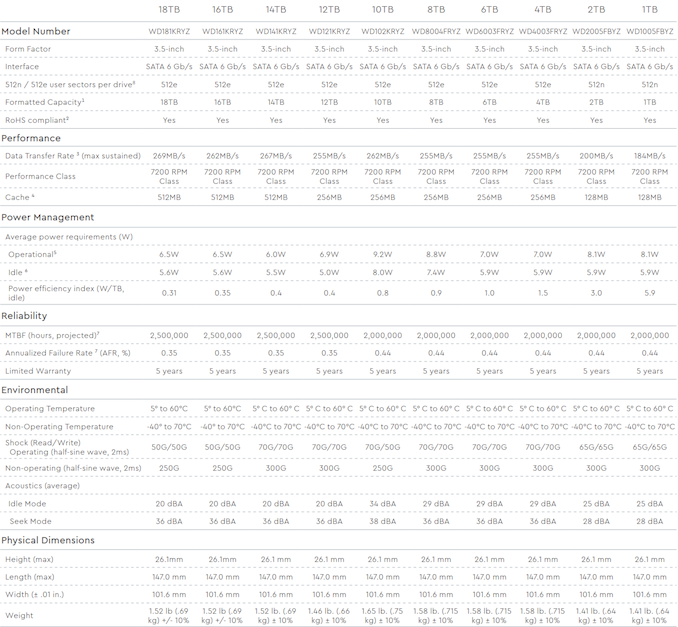Western Digital's 16TB and 18TB Gold Drives: EAMR HDDs Enter the Retail Channel
by Ganesh T S on July 9, 2020 8:00 AM EST- Posted in
- Storage
- HDDs
- NAS
- Western Digital
- MAMR
- Helium HDD
- HAMR
- CMR
- EAMR

Western Digital made a number of announcements yesterday related to their enterprise hard-disk drives (HDD) product lines. While there was nothing unexpected in terms of the products being announced, two aspects stood out - one was the retail availability of EAMR (energy-assisted magnetic recording) HDDs, and the other was additional information on the EAMR technology itself. In 2019, WD had announced the sampling of EAMR-based Ultrastar DC datacenter HDDs with 18TB and 20TB capacities. Yesterday's announcements build upon those products - the WD Gold-branded version of the Ultrastar DC CMR drives is now available for retail purchase, and the Ultrastar drives themselves have moved to general availability. The Ultrastar JBOD and storage server product lines have also been updated to utilize these new high-capacity drives.
Flash-based storage devices have taken over traditional consumer hard-drive application areas. However, increasing data storage requirements mean that HDDs still continue to be the most cost-effective solution for bulk storage. HDD vendors have been working on increasing hard drive capacities using multiple techniques. Around 10 years back, we had 2TB 3.5" HDDs with five PMR (perpendicular magnetic recording) platters in an air-filled enclosure. These drives were CMR (conventional magnetic recording) drives. In the last decade, we have seen advancements in three different categories that have enabled a 10-fold increase in the capacity of HDDs while retaining the same physical footprint:
Increasing the number of platters / making the platters thinner has been made possible by using sealed helium-filled enclosures. The reduced turbulence enables platters to be stacked closer to each other. The first-generation helium HDDs had 7 platters, and this has now grown to 9 platters for the new high-capacity drives.
The size of the writing head and the flexibility with which it can be manipulated dictate the minimum width of the recording tracks on the platters. Western Digital is claiming that they are the first to use a triple-stage actuator (TSA) in shipping HDDs.

The enhanced precision with TSA allows the TPI factor to go up. Incidentally, Seagate also has a novel actuator scheme (dual actuator), though that is aimed at increasing the throughput / IOPS.
One of the key challenges faced in the quest to increase the areal density of platters is the ability of the writing head to reliably alter the magnetic state of the grains in the tracks. Both heat-assisted magnetic recording (HAMR) and microwave-assisted magnetic recording (MAMR) are techniques that address this issue. In 2017, WD seemed set to go all-in on MAMR for their HDD product line, but three years down the road, we are looking at a variant that WD claims is a product of their HAMR and MAMR research - EAMR (energy-assisted magnetic recording).
While details were scant when EAMR was announced , WD is finally opening up on some of the technical aspects.

WD's first-generation EAMR technology (christened as ePMR) involves the application of electrical current to the writing head's main pole (this is in addition to the current sent through the voice coil) during write operations. The additional magnetic field created by this bias current ensures that the bits on the track alter their state in a more deterministic manner. In turn, this allows the bits to be packed closer together and increasing the areal density.
The above techniques can also be used with shingled magnetic recording (SMR) to boost areal density further. SMR has been around in both host-managed and drive-managed versions for a few years now. WD indicated in yesterday's announcement that qualification shipments of their 20TB Ultrastar DC host-managed SMR drive are in progress.

The WD Gold 18TB is available for purchase today and will set you back by $593. The 16TB version is priced at $528, but is currently out of stock. As is typical for enterprise drives, the two new models each have a MTBF of 2.5M hours, workload rating of 550TB/yr, and a 5 year warranty.
Source: Western Digital










69 Comments
View All Comments
prisonerX - Thursday, July 9, 2020 - link
Straw man arguments are the stock in trade of these idiots. Comment sections are classic example of the tragedy of the commons.Ryan Smith - Thursday, July 9, 2020 - link
"I wouldnt be surprised if its a sponsored article by a failing industry (not saying it is)"And it isn't. If it were a sponsored article, it would be very clearly labeled as such. It's quite illegal not to disclose such things.
imaheadcase - Thursday, July 9, 2020 - link
But to be fair its not illegal to mismatch real articles alongside tons of ads to make clicking them easier on accident. I mean even this site has the stupid "You won't believe what so and so looks like now!" and other dumb ads.prisonerX - Thursday, July 9, 2020 - link
Just install an ad blocker and stop whining.name99 - Thursday, July 9, 2020 - link
What's your complaint? Are you saying we had larger than 2TB drives in 2010?3TB was introduced at the end of 2010 (technically later than "ten years ago")
https://www.anandtech.com/show/3858/the-worlds-fir...
Till then the hot excitement, the state of the art, for 2010, was 2TB
https://www.anandtech.com/show/2866
The statement is essentially correct: in ten years drives are 10x larger in capacity, same size physically. Are you unhappy than 9x is not exactly 10x?
As for cost, that has basically doubled (for that 9x increase in capacity)
https://hothardware.com/reviews/definitive-2tb-har...
but since no-one made any claims about how costs were changing, again I don't understand why you're so mad.
abhaxus - Thursday, July 9, 2020 - link
I'm not going to invest a ton of time here, but a quick internet search shows the Barracuda XT 2TB was priced over $300 when it launched, and that's for a desktop quality drive. Enterprise versions surely would have been more expensive (although perhaps not twice as expensive). I think you're looking for something to complain about that isn't really an issue.mukiex - Monday, July 13, 2020 - link
"Around 5 years ago, we had 8TB 3.5" HDDs for $150. Today, they cost the same fucking price to the same."So much progress.
Brane2 - Thursday, July 9, 2020 - link
It's interesting to see marketing BS pipeline at work."Experts" simply forward the crap that they are fed to.
If they had been served some story about schroedinger's cat rearanging the magnetic domains, they'd go happily with that.
Whatever sells adverts.
MrSpadge - Thursday, July 9, 2020 - link
Care to educate us on the truth?prisonerX - Thursday, July 9, 2020 - link
Yes clearly experts are the problem, not addled and ignorant anonymous posters in internet forums bearing conspiracy theories.